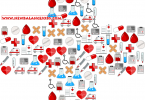The number of beers it takes to get drunk varies depending on factors, including a person’s weight, gender, and tolerance to alcohol.
However, it is important to note that consuming excessive amounts of alcohol can lead to serious health risks and should be avoided.
With that being said, it’s essential to understand the effects of alcohol and how it can affect the body and mind.
In this article, we will explore the estimated amount of beer needed to reach a state of being drunk. We will also discuss the risks and considerations associated with excessive alcohol consumption.
SEE ALSO: Top paying Federal government jobs in 2023
Factors that Affect Alcohol Tolerance
Alcohol tolerance is the body’s ability to process and metabolize alcohol. For you to get drunk with beers, several factors come into consideration. They include the following:
Body weight
A person’s weight plays a significant role in how alcohol affects the body. Generally, the more a person weighs, the more alcohol they can consume before feeling its effects.
This is because the higher the body weight, the more water in the body, which dilutes the alcohol and slows down the absorption rate.
Gender
Men tend to have a higher tolerance for alcohol than women due to differences in body composition and how their bodies process alcohol.
Men have a higher percentage of water in their bodies, which dilutes the alcohol and slows down the absorption rate.
They also have a higher level of the enzyme that breaks down alcohol, called dehydrogenase, which helps to remove the alcohol from the body faster.
Genetics
Some people may have a genetic predisposition to a lower tolerance for alcohol. Certain genes are associated with alcohol metabolisms, such as ADH1B, ALDH2, and GABRA2.
These genes can affect how a person’s body processes alcohol, leading to lower tolerance.
Drinking habits
Regularly consuming large amounts of alcohol can increase tolerance to its effects. The more you drink, the more your body becomes accustomed to the presence of alcohol and the less of an impact it has on your system.
However, it’s important to note that regularly drinking large amounts of alcohol can lead to other health problems.
Medications
Certain medications can interact with alcohol and affect a person’s tolerance. For example, antidepressants, painkillers, and sleeping pills can increase the effects of alcohol, making a person feel drunk faster.
Food
Eating a meal before drinking can slow down the absorption of alcohol into the bloodstream. The food in the stomach can slow down the rate at which the alcohol is absorbed, which means that it takes longer to feel the effects of the alcohol.
It’s important to note that everyone’s tolerance to alcohol is different and can be affected by various factors. Additionally, tolerance can change over time, so it’s important to be aware of your limits and always drink responsibly.
SEE ALSO: York University Science International Entrance Scholarship in Canada
How Many Beers to Get Drunk
The effects of alcohol can vary greatly depending on the individual. However, on average, it takes about 3-4 beers for a man to get drunk, and for a woman, it takes about 2-3 beers.
It’s important to remember that these are estimates and can vary depending on several factors. The alcohol content of beer can vary widely, with some beers having a higher alcohol content than others.
For example, a “light” beer may have an alcohol content of 3-4%, while a “heavy” beer may have an alcohol content of 7-8%. This means that it may take fewer “light” beers to reach a state of being drunk than it would take “heavy” beers.
The rate of drinking also plays a role in how quickly a person becomes drunk. Consuming alcohol quickly, such as taking shots, will increase the blood alcohol level faster than drinking beer at a slower pace.
Additionally, factors such as body weight, gender, genetics, drinking habits, medications, and food can affect how quickly a person becomes drunk.
It’s important to remember that alcohol affects everyone differently, and it’s essential to know your limits.
Start with lower quantities and monitor the effects and symptoms of alcohol, such as slurred speech, lack of coordination, and impaired judgment, before consuming more.
It’s vital to drink responsibly and never to drink and drive. Additionally, it’s crucial to be aware of the risks and considerations associated with excessive alcohol consumption. Seek help if you have a problem with alcohol.
Risks and Considerations of Getting Drunk With Beers
Excessive alcohol consumption can lead to several serious health risks, including:
1. Liver damage
The liver is responsible for breaking down and removing toxins from the body, including alcohol.
Consuming excessive amounts of alcohol can lead to a buildup of toxins in the liver, which can cause inflammation and damage to the liver cells.
This can lead to alcoholic fatty liver, alcoholic hepatitis, and liver cirrhosis.
2. High blood pressure
Consuming excessive amounts of alcohol can increase blood pressure, increasing the risk of heart disease and stroke.
3. Increased risk of certain cancers
Excessive alcohol consumption can cause an increased risk of certain cancer types, including mouth, throat, esophagus, liver, and breast cancer.
4. Brain damage
Excessive alcohol consumption can lead to brain damage, affecting memory, cognitive function, and coordination.
5. Nutritional deficiencies
Excessive alcohol consumption can lead to a lack of essential nutrients in the body, leading to health problems.
6. Accidents and injuries
Excessive alcohol consumption can impair judgment, coordination, and reaction time, increasing the risk of accidents and injuries, such as car crashes and falls.
7. Risky behavior
Excessive alcohol consumption can lead to poor decision-making, resulting in risky behavior, violence, and legal issues.
8. Psychological and social problems
Excessive alcohol consumption can lead to psychological and social problems, such as depression, anxiety, and relationship problems. It can also lead to financial problems, as excessive alcohol consumption can be expensive.
9. Alcohol addiction
Excessive alcohol consumption can lead to alcohol addiction, also known as alcoholism. This chronic disease leads to an uncontrollable need to consume alcohol, despite the negative consequences.
It’s important to remember that excessive alcohol consumption can lead to many serious health risks and should be avoided.
If you are concerned about your alcohol consumption, it’s important to seek help from a healthcare professional.
Several resources, such as counseling, support groups, and treatment programs, can help you reduce your alcohol consumption and improve your overall health and well-being.
In addition to the health risks, excessive alcohol consumption can negatively impact a person’s social life, family, and work.
It is important to be aware of these impacts and to seek help if you or someone you know may have a problem with alcohol.
Ultimately, drink alcohol responsibly and in moderation. It is important to understand how getting drunk with beers can affect the body and mind.
SEE ALSO: 2-Year Nursing Programs in the USA for International Students
Conclusion
The number of beers it takes to get drunk depends on several factors. These include a person’s weight, gender, and tolerance to alcohol.
However, it is important to note that consuming excessive amounts of alcohol can lead to serious health risks and should be avoided.
It’s essential to understand the effects of alcohol and how it can affect the body and mind.
Always remember to know your limits, drink responsibly, and never drink and drive.






